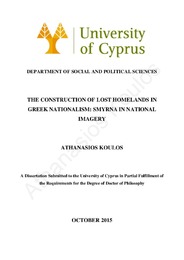| dc.contributor.advisor | Mavratsas, Caesar V. | en |
| dc.contributor.author | Koulos, Athanasios N. | en |
| dc.coverage.spatial | Κύπρος | el |
| dc.coverage.spatial | Cyprus | en |
| dc.creator | Koulos, Athanasios N. | en |
| dc.date.accessioned | 2016-02-08T06:32:55Z | |
| dc.date.accessioned | 2017-08-03T09:56:43Z | |
| dc.date.available | 2016-02-08T06:32:55Z | |
| dc.date.available | 2017-08-03T09:56:43Z | |
| dc.date.issued | 2015-12 | |
| dc.date.submitted | 2015-12-21 | |
| dc.identifier.uri | https://gnosis.library.ucy.ac.cy/handle/7/39290 | en |
| dc.description | Includes bibliographical references (p. 164-179) | en |
| dc.description | Number of sources in the bibliography: 299 | en |
| dc.description | Thesis (Ph. D.) -- University of Cyprus, Faculty of Social Sciences and Education, Department of Social and Political Sciences, 2015. | en |
| dc.description | The University of Cyprus Library holds the printed form of the thesis. | en |
| dc.description.abstract | Η Μικρασιατική καταστροφή του 1922 και η επακόλουθη ανταλλαγή πληθυσμών μεταξύ της Ελλάδας και της Τουρκίας σηματοδότησε το τέλος της ελληνικής παρουσίας στη Μικρά Ασία και την αποτυχία του εθνικιστικού σχεδίου της ‘Μεγάλης Ιδέας’. Έκτοτε, οι ‘Χαμένες Πατρίδες’ αποτελούν σημείο αναφοράς της ελληνικής κουλτούρας, καθώς η καταστροφή άλλαξε συθέμελα τον χαρακτήρα του ελληνικού έθνο-κράτους.
Στο πλαίσιο της κατασκευής του ελληνικού έθνους πριν το 1922, η Μικρά Ασία προβάλλετο ως ελληνική περιοχή. Αυτή η διαδικασία εθνικοποίησης/ελληνοποίησης του χώρου είχε ως στόχο να υποστηρίξει εθνικές εδαφικές διεκδικήσεις. Στηv εποχή μετά την καταστροφή, η διαδικασία αυτή συνεχίστηκε ακάθεκτη με διαφορετικό, ωστόσο, στόχο. Πλέον, η εθνικοποίηση/ελληνοποίηση του χώρου αποσκοπεί στη δημιουργία της εικόνας μιας ελληνικής Μικράς Ασίας ανά τους αιώνες, μέσω της κατασκευής των ‘Χαμένων Πατρίδων’.
Η ιδέα αυτή ανακατασκευάζει σε ένα φαντασιακό επίπεδο την ‘ελληνικότητα’ των υποτιθέμενων ‘χαμένων’ περιοχών και η διαδικασία εθνικής συγκρότησης ενισχύει την εικόνα τους ως ελληνικές προγονικές πατρίδες. Ωστόσο, δεν καταφέρνει να εξηγήσει πώς γίνεται να χάσουμε κάτι το οποίο δεν ήταν θεσμικά ‘δικό μας’. Καθώς το ελληνικό στοιχείο της Μικράς Ασίας ήταν μια μειονότητα στην περιοχή και οι περιοχές που καταλήφθηκαν από τον ελληνικό στρατό κατά την Μικρασιατική εκστρατεία δεν ενώθηκαν ποτέ επίσημα με την Ελλάδα, οι πεποιθήσεις για τις ‘Χαμένες Πατρίδες’ του έθνους είναι μάλλον προϊόντα της εθνικής φαντασίας και μυθοπλασίας.
Η διατριβή αυτή διερευνά την ιδέα των ‘Χαμένων Πατρίδων’ της Μικράς Ασίας, και κυρίως της Σμύρνης, ως ενός ελληνικού εθνικού μύθου. Το κεντρικό επιχείρημα είναι πως η ιδέα των ‘Χαμένων Πατρίδων’ έχει αναχθεί σε χαρακτηριστικό της ελληνικής εθνικής ιδεολογίας και συστατικό στοιχείο της ελληνικής εθνικής ταυτότητας, το οποίο ενισχύει το συλλογικό αίσθημα του ανήκειν. Πηγάζοντας από το συλλογικό τραύμα της ήττας του 1922, λειτουργεί ως υπενθύμιση του τί έκαναν ‘αυτοί’ σε ‘εμάς’, σκιαγραφώντας τον εθνικό εαυτό και τη μοναδικότητα της ιστορίας και της μοίρας του έθνους, ενώ ταυτόχρονα συνδέει τα μέλη του μέσω του συλλογικού πόνου για το χαμό αυτών των πατρίδων. Εκείνο που παρατηρούμε σε τέτοιες περιπτώσεις – ανταλλαγών πληθυσμών, εθνικών εκκαθαρίσεων ή και γενοκτονίας – είναι ότι τίθενται σε λειτουργία οι μηχανισμοί για την πιστοποίηση μιας εθνικής ταυτότητας και την ύστατη επιβεβαίωση μιας συλλογικής ύπαρξης.
Αυτή η διατριβή εξετάζει το ρόλο του προσφυγικού σωματείου ‘Ένωσις Σμυρνέων’ και του περιοδικού ‘Μικρασιατικά Χρονικά’ στη διαδικασία αυτή της αναγωγής της Σμύρνης σε μύθο του ελληνικού εθνικισμού, αναλύοντας τη συνεισφορά της ‘Ένωσης’ στην ανακατασκευή της ελληνικότητας της Σμύρνης. Έχοντας τις βάσεις της στο μοντέλο του εθνο-συμβολισμού του Άντονι Σμίθ για την κατασκευή της πατρίδας, η διατριβή αυτή συμβάλλει σημαντικά στη μελέτη του εθνικισμού, καθώς εξετάζει την υιοθέτηση του μοντέλου αυτού όχι μόνο για τη κατασκευή της πατρίδας, αλλά και για την ανάλυση της κατασκευής της ‘χαμένης’ πατρίδας. Η διατριβή συμβάλλει επίσης στην κατανόηση της διάστασης του χώρου των εθνικών ταυτοτήτων, τις συνέπειες της αναγκαστικής μετακίνησης πληθυσμών στις πολιτικές της ταυτότητας και στη δημιουργία εθνικών μύθων και συμβόλων, καθώς και στη μελέτη της Μικρασιατικής καταστροφής, της ανταλλαγής πληθυσμών του 1922 και στον τρόπο που επηρέασε την ελληνική εθνική ταυτότητα. Τέτοιες περιπτώσεις εθνικών μύθων είναι σημαντικές στην προσπάθειά μας να κατανοήσουμε τις σύγχρονες εθνικές ταυτότητες καθώς και τις ρίζες των εθνικών συγκρούσεων. | el |
| dc.description.abstract | The Asia Minor disaster in September 1922 and the subsequent population exchange between Greece and Turkey marked the end of Greek presence in Asia Minor and the failure of the nationalist dream of the ‘Megali Idea’. Ever since, the ‘Lost Homelands’ have been a point of reference in Greek culture, as the disaster changed the worldview and character of the Greek nation-state.
In the context of Greek nation-building before 1922, Asia Minor had been unequivocally projected as Greek. This process of nationalization/hellenization of space was designed to back up national territorial claims. In the post-disaster era, however, it continued unabated, albeit this time around seeking to articulate an image of a Greek Asia Minor through time immemorial by building ‘Lost Homelands’.
This concept reconstructs on an imaginary level the ‘Greekness’ of the allegedly ‘lost’ territories, while the nation-building process reinforces their image as ancestral Greek homelands. However, nation-building fails to give an account of how we can lose something that was never institutionally ‘ours’. As the Anatolian Greeks were a minority in the region, and the areas occupied by Greek troops during the Asia Minor campaign were never officially united with the Greek state, all the miscellaneous perceptions about the ‘Lost Homelands’ of the nation seem to fall within the scope of national imagination and mythology.
This thesis examines the idea of the Lost Homelands of Asia Minor, and Smyrna in particular, as a Greek national myth. The main argument is that the idea of the Lost Homelands has turned into a key feature of Greek nationalist ideology and a constituent element of Greek national identity that induces sentiments of national belonging. It functions as a reminder formed out of the collective trauma of the defeat about what ‘they’ did to ‘us’, formulating an idea of the national self and of the unique history and destiny of the nation and binding its members under the common suffering for the loss of those homelands. What we see in cases like this – of population exchange, ethnic cleansing or genocide – is the operation of mechanisms for the authentication of a national identity and the ultimate verification of communal existence.
This thesis explores the role of the refugee association ‘Enosis Smyrneon’ (Union of Smyrniots), and its journal Mikrasiatika Chronika (Asia Minor Chronicles) in this process. Embarking from the ethno-symbolist model of Anthony Smith on the construction of homeland, this thesis contributes to the studies of nationalism, by employing this model to analyze the construction also of the lost homeland. It further contributes to the studies of the spatial dimensions of national identities, the effects of forced population transfers in identity politics and the creation of national myths and symbols, as well as the Asia Minor disaster studies, the 1922 population exchange and its impact on Greek national identity. Cases like this are important in any attempt to understand modern national identities, as well as the roots of ethnic conflicts. | en |
| dc.format.extent | x, 196 p. : ill. (some col.), maps (some col.) ; 30 cm. | en |
| dc.language.iso | eng | en |
| dc.publisher | Πανεπιστήμιο Κύπρου, Σχολή Κοινωνικών Επιστημών και Επιστημών Αγωγής / University of Cyprus, Faculty of Social Sciences and Education | |
| dc.rights | info:eu-repo/semantics/openAccess | en |
| dc.rights | Open Access | en |
| dc.subject.lcsh | Nationalism -- Greece -- History | en |
| dc.subject.lcsh | Ethnicity -- Greece | en |
| dc.subject.lcsh | Greco-Turkish War, 1921-1922 | en |
| dc.subject.lcsh | Greco-Turkish War, 1921-1922 -- Refugees -- Greece | en |
| dc.subject.lcsh | Population transfers -- Greeks | en |
| dc.subject.lcsh | Nationalism and literature -- Greece | en |
| dc.subject.lcsh | Asia Minor -- History | en |
| dc.title | The construction of lost homelands in greek nationalism : Smyrna in national imagery | en |
| dc.title.alternative | Η κατασκευή των Χαμένων Πατρίδων στον Ελληνικό Εθνικισμό: Η Σμύρνη στην Εθνική Φαντασία | el |
| dc.type | info:eu-repo/semantics/doctoralThesis | en |
| dc.contributor.committeemember | Μαυράτσας, Καίσαρ Β. | el |
| dc.contributor.committeemember | Έλληνας, Αντώνης Α. | el |
| dc.contributor.committeemember | Παπαδάκης, Γιάννης | el |
| dc.contributor.committeemember | Ιωάννου, Γιάννης | el |
| dc.contributor.committeemember | Δραγώνα, Θάλεια | el |
| dc.contributor.committeemember | Mavratsas, Caesar V. | en |
| dc.contributor.committeemember | Ellinas, Antonis A. | en |
| dc.contributor.committeemember | Papadakis, Yiannis | en |
| dc.contributor.committeemember | Ioannou, Yiannis | en |
| dc.contributor.committeemember | Dragona, Τhalia | en |
| dc.contributor.department | Πανεπιστήμιο Κύπρου, Σχολή Κοινωνικών Επιστημών και Επιστημών Αγωγής, Τμήμα Κοινωνικών και Πολιτικών Επιστημών | el |
| dc.contributor.department | University of Cyprus, Faculty of Social Sciences and Education, Department of Social and Political Sciences | en |
| dc.subject.uncontrolledterm | ΕΘΝΙΚΙΣΜΟΣ, ΈΘΝΟΣ | el |
| dc.subject.uncontrolledterm | ΕΘΝΙΚΗ ΤΑΥΤΟΤΗΤΑ | el |
| dc.subject.uncontrolledterm | ΕΘΝΙΚΟΙ ΜΥΘΟΙ, ΣΥΜΒΟΛΑ | el |
| dc.subject.uncontrolledterm | ΕΘΝΟ-ΣΥΜΒΟΛΙΣΜΟΣ | el |
| dc.subject.uncontrolledterm | ΜΙΚΡΑΣΙΑΤΙΚΗ ΚΑΤΑΣΤΡΟΦΗ | el |
| dc.subject.uncontrolledterm | ΣΜΥΡΝΗ | el |
| dc.subject.uncontrolledterm | ΧΑΜΕΝΕΣ ΠΑΤΡΙΔΕΣ | el |
| dc.subject.uncontrolledterm | ΕΛΛΗΝΙΚΟΣ ΕΘΝΙΚΙΣΜΟΣ | el |
| dc.subject.uncontrolledterm | NATION, NATIONALISM | en |
| dc.subject.uncontrolledterm | NATIONAL IDENTITY | en |
| dc.subject.uncontrolledterm | NATIONAL MYTHS AND SYMBOLS | en |
| dc.subject.uncontrolledterm | ETHNO-SYMBOLISM | en |
| dc.subject.uncontrolledterm | ASIA MINOR DISASTER | en |
| dc.subject.uncontrolledterm | SMYRNA | en |
| dc.subject.uncontrolledterm | LOST HOMELANDS | en |
| dc.subject.uncontrolledterm | GREEK NATIONALISM | en |
| dc.identifier.lc | JC311.K68 2015 | en |
| dc.author.faculty | Σχολή Κοινωνικών Επιστημών και Επιστημών Αγωγής / Faculty of Social Sciences and Education | |
| dc.author.department | Τμήμα Κοινωνικών και Πολιτικών Επιστημών / Department of Social and Political Sciences | |
| dc.type.uhtype | Doctoral Thesis | en |
| dc.rights.embargodate | 2018-12-21 | |


